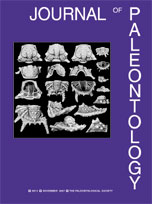The cephalon of Nephrolenellus multinodus and its stratigraphically higher sister-taxon N. geniculatus passed through the same four successive phases of development: entry into phase 2 is defined by a change from a decrease to an increase in the dynamic pattern of distance between the intergenal spine bases relative to cephalic length; entry into phase 3 is defined by the appearance of genal spines; and entry into phase 4 is defined by the effective isolation of glabellar furrow S3 from the axial furrow. Phase transitions were associated with significant changes in allometric growth patterns of the cephalon. Five instars are identified within the early development (phases 1 and 2) of N. multinodus. Despite the general similarity in cephalic ontogeny, significant interspecific differences in patterns of shape change are documented throughout phases 1, 2, and 3 of cephalic development which, with differences in rates of glabellar shape change relative to size (higher in N. multinodus) and ontogenetic loss of glabellar axial nodes (higher in N. geniculatus), demonstrate that evolutionary modification to ontogeny was mosaic and complex. Stratigraphic occurrences and a temporal trend towards increased rate of glabellar axial node loss relative to size in N. geniculatus are consistent with a hypothesis that N. geniculatus was a direct descendant of N. multinodus. However, ontogenetic data are needed for immediate outgroups of Nephrolenellus to determine whether two potential autapomorphies of N. multinodus, which refute such a hypothesis, are indeed unique to this taxon. Nephrolenellus jasperensis is recognized as a junior synonym of N. multinodus.
How to translate text using browser tools
1 November 2007
ONTOGENY AND EVOLUTION OF THE EARLY CAMBRIAN TRILOBITE GENUS NEPHROLENELLUS (OLENELLOIDEA)
Mark Webster
ACCESS THE FULL ARTICLE

Journal of Paleontology
Vol. 81 • No. 6
November 2007
Vol. 81 • No. 6
November 2007




